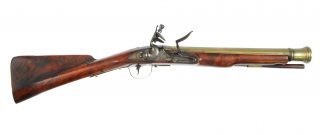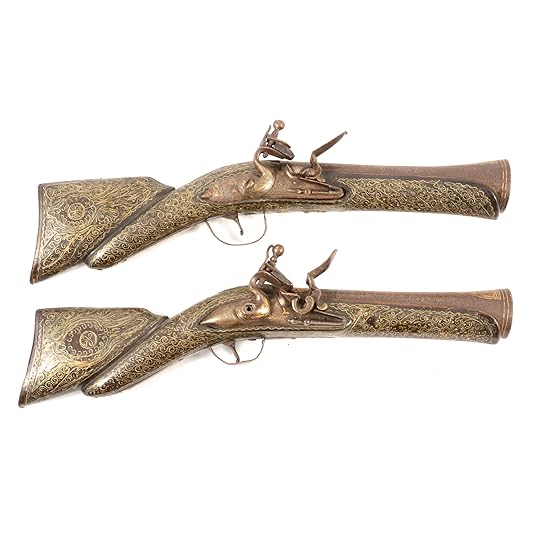The Time Machine: Muskets, Rifles, and Blunderbusses- Oh My!
Explain it to me like I’m a gun-shy pacifist barefoot hippie leftist from Southern California.
-Me on Scribophile, asking for advice on writing guns
***Full disclosure*** This is a very short, very shallow general overview. I am not an expert on guns, I only know enough to write them into my stories, which are set in the 1790s-1810s. This post is intended to answer basic questions for the curious, not to serve as an extensive primer on how to find and use them.
The Journey to Europe
The earliest firearms, called fire lances, where developed in China in the 10th century. They were essentially bamboo or paper tubes filled with gunpowder, and would be affixed to the ends of spears, to shoot fire at the enemy. The tubes would be made into metal, with small projectiles added, and eventually developed into the hand canon in the 13th century.
By the 15th century, the firearm had spread throughout Asia and made its way to Europe in the form of the arquebus, which is immediately recogniseable as a gun. It has a shoulder stock, long metal barrel, priming pan, and matchlock (an ignition system using a long lit fuse used to light the powder)- and was crucially the first firearm to come equipped with a trigger mechanism.
Muskets
From the arquebus, we get the musket. The musket has a long and proud history in Western history. The word, musket, could come from from the French word for sparrowhawk, the Italian word for fly, or the French or Italian word for a crossbow bolt. Something small, fast, and often lethal.
The way a musket was loaded was to pour a little black powder into the pan (and cover with the frizzen to keep it in place) and the rest down the muzzle (either from a pouch or a pre-measured paper cartridge), followed by the wadding (either the paper from the cartridge or a piece of fabric rag), and ending with the lead or iron ball. The ramrod is pulled out from its place under the barrel and used to stuff everything in tight, then returned. To prime, you pull the hammer back to half-cock, or one click, and close the lid of the priming pan. To fire, you pull the hammer back one more click to full-cock, put the butt to the hollow of your shoulder, aim, and squeeze the trigger.
The musket uses a flintlock ignition system, where a piece of flint in the hammer strikes the frizzen, creating a spark, which falls on the powder in the priming pan.
A bayonet, basically a knife on a ring, could be added to the barrel to turn the gun into a spear, ideal for charging the enemy.
Compared to bows, the preferred weapon of Europe from prehistory even into the 1600s, muskets fired much slower. An archer could fire six arrows in the time it took a musketeer to load and fire one shot (musketeers could fire 4 shots a minute), though obviously musket balls did much more damage. If they hit, of course. Muskets were notoriously inacurate, especially at greater distances, and tended to backfire and injure the wielder.
Rifles
To combat (lol) these concerns, innovations were made to the barrel. It’s interesting to note how early these innovations were made, potentially inspired by archery, actually. Pretty early on, fletchers noticed how much more accurate their arrows were when they added a bit of spin to the feathers on the fletching.
Part of the issue with muskets is that the ball sits pretty loose in the smoothbore barrel (if you point the muzzle down, the ball can fall right out, lol), so when the gasses expand from the lit powder, the ball can bounce along the length of the barrel, which eats up a lot of energy, costing a lot of distance and making the accuracy a little unpredictable. The twisting grooves inside the barrel, the rifling, makes for a tighter fit, and as the gasses expand, they heat up the ball, which deforms to fill the grooves, then as it is pushed out, it spins in the grooves. That spin gives it greater distance and accuracy.
So, why didn’t everyone switch over to rifles? Well, that added little bit of innovation required a lot of extra time and skill, which made them a lot more expensive to buy, both personally and to outfit an army. They also took a lot longer to load. Typically, you could load and fire a rifle twice in a minute, with three being possible if the rifleman was really quick.
So, that math is 2 (and a half, let’s say) shots per minute for a rifle, 4 per minute for a musket, and 24 arrows per minute for a skilled archer. Now, the accuracy: muskets have up to a 48% accuracy at 200 yards, and 18% at 300. That’s a sharp dip. Rifles have 58% at 300 yards and 42% at 500. I don’t have the numbers for archery because there are SO many factors, like wind, altitude, draw weight, skill of the archer, etc. But it also needs to be noted that ammunition has an effect- musket balls can be made in the field by melting lead and pouring them into moulds, whereas arrows take a lot of time and skill to make something that will fly straight. So, yeah, the popularity of the rifle makes sense.
Now, there are no rifles in my books, yet. Like I said, I had to include rifles in the post becase it’s hard to talk about muskets without also discussing rifles. However, neither of my characters would be able to afford to buy a rifle, and by the time they can, they don’t have the immediate need for one. Alois was part of an elite regiment during the war, but the way weapon innovaton happened in the history of my books, the ironmongers favoured power and speed over accuracy, which I will go into a bit more later.
Blunderbusses
The blunderbuss is not a progression of the musket-rifle, but more a cousin of the arquebus, the shorter, stockier, louder descendant of the hand canon, and the ancestor of the shotgun.
The word comes from Dutch, meaning THUNDER BOX, which is charming; mixed with ‘blunder’, meaning to confuse, which seems to be a reference to how goddamn loud and disorienting it is. Sulat carries one, and she is not a subtle lady.
The blunderbuss has a short barrel with a flared muzzle, designed to fire shot (pellets) or other large projectiles. Basically, you can load it with anything, from a handful or gravel to a musket ball. It is also a flintlock, with a load of brass hardware, in addition to the ironwork
Bonus: Alois’ Dragon Pistols and the Ettin Gun
Ok, so those are the recogniseable guns that you’ll see in my books. But there are two more types that are mentioned frequently: Alois’ pair of dragons and his Ettin Gun.
A dragon or dragoon was also a real gun, basically a pistol version of the blunderbuss. It was much shorter, and still designed for shot and still very loud. It was called a dragon because of how intimidating that report was, but also because they tended to be carved with dragons along the brass barrel, which is kinda cute. Alois carries a pair of them. He is a better swordsman than Sulat, but a worse shot; she is a better shot, but her slight build means she prefers to fight from a distance.
~~
The Ettin Gun is my own invention. It is a combination between an elephant gun and a 4-barrel pistol, which are both real guns. Multiple-barrel guns, like the rotating pepper-box, are nothing new. They allow multiple barrels to be loaded at one time, though the single flintlock mechanism requires that each be primed individually. Still, it cuts back on load time significantly.

The elephant gun was developed much later, as Europeans stormed into Africa for the purpose of big game hunting. My military engineers had to speed up the timeline a bit to deal with the invasion of two-headed giants onto their own lands.

The combination created a giant 4-barrelled musket that required extensive training, a tonne of equipment, and a weilder with enough shoulder meat to handle that kind of kickback in rapid succession. Alois still has his Ettin gun, but its inherent value and scarcity since the end of the war makes it something of a theft liability, so he keeps it hidden away.
~~~~
So, there you have it, a brief toe-dip into the world of popular flintlock guns. I have seen some fun novelty ones, like a rifle with a heart-shaped muzzle. What other interesting weapons would you like to see me explore?



